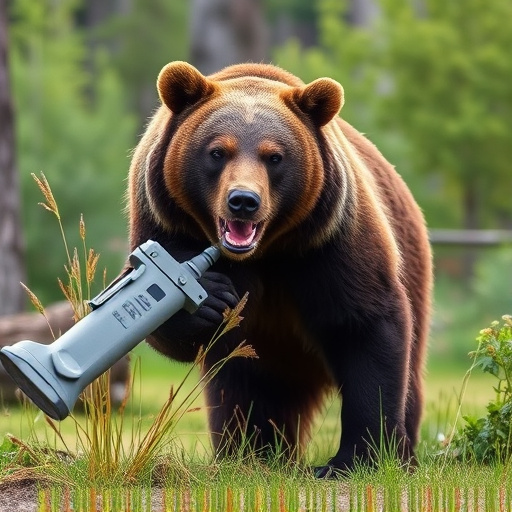Bear spray is a critical self-defense tool in bear-inhabited areas, offering up to 80-100 feet of protection under ideal conditions. However, its effectiveness depends on factors like soil contamination, wind, and application technique, reducing its duration. Responsible usage includes aiming at bears' faces and eyes from close range (20-30 feet) and avoiding direct spraying onto the ground to prevent ecological harm. Proper storage, disposal, and awareness of expiration dates ensure bear spray remains a reliable defense mechanism for campers in Alaska's wilderness, balancing safety with environmental conservation.
“Camping under the stars, amidst nature’s beauty, is a thrilling experience but comes with essential safety considerations. One of your best allies in the wild? Bear spray, specifically Guard Alaska spray. This article guides you through enhancing your camping safety with this powerful tool. We’ll explore the science behind bear spray, its effectiveness against aggressive bears, and how proper usage can ensure your outdoor adventure remains unforgettable. Additionally, we’ll delve into preventing soil contamination, optimizing spray duration for maximum protection, and responsible camping practices.”
- Understanding Bear Spray: Its Effectiveness and Usage
- Preventing Soil Contamination While Camping
- Optimizing Bear Spray Duration for Maximum Protection
- Essential Tips for Safe and Responsible Camping with Guard Alaska Spray
Understanding Bear Spray: Its Effectiveness and Usage
Bear spray, also known as bear deterrent or bear repellent, is a crucial tool for outdoor enthusiasts and campers in areas inhabited by bears. It’s designed to protect against potential attacks and enable safe navigation through bear country. When used correctly, bear spray can be highly effective in deterring bears from approaching humans.
The effectiveness of bear spray lies in its ability to create a barrier of chemicals that bears find unpleasant or irritating. However, it’s important to understand the spray’s limitations. Bear spray is most effective when used as a last resort and at close range, typically within 20-30 feet (6-9 meters). Proper usage involves aiming the spray directly into the bear’s face and eyes. Despite its powerful effect, bear spray can be affected by soil contamination or heavy wind, reducing its duration and effectiveness. Therefore, users should always follow the instructions provided by manufacturers like Guard Alaska to ensure optimal performance during outdoor adventures.
Preventing Soil Contamination While Camping
When camping, preventing soil contamination is an essential aspect of leaving no trace and maintaining a healthy environment. One of the primary concerns is the potential impact of bear spray on the ecosystem. Bear spray is a popular self-defense tool for campers, but its improper use can lead to environmental damage. The key to minimizing soil contamination lies in understanding the duration of its effectiveness and responsible application.
During camping trips, it’s crucial to store and dispose of bear spray properly. Avoid spraying directly onto the ground, as this can cause long-lasting residue build-up, harming plants and wildlife. Instead, use the spray for self-defense when necessary, targeting specific individuals or groups that pose an immediate threat. By following these guidelines, campers can ensure a safe and sustainable outdoor experience while minimizing the ecological footprint, particularly in sensitive environments like Alaska’s diverse wilderness areas.
Optimizing Bear Spray Duration for Maximum Protection
When it comes to bear spray, understanding its duration and optimal usage is paramount for campers in Alaska’s wild landscapes. Guard Alaska bear spray, known for its powerful formula, offers significant protection against aggressive bears. However, to ensure maximum effectiveness, it’s crucial to consider factors like application technique, weather conditions, and soil contamination.
The spray’s duration varies based on these elements. In ideal conditions, a single can of Guard Alaska bear spray can provide up to 80-100 feet of protection. But in harsh weather or when the spray comes into contact with wet soil, its reach may be reduced. Proper usage involves aiming for the bear’s face and eyes, ensuring every puff counts. Regular maintenance, such as checking expiration dates and keeping the canister secure from moisture, can also extend the spray’s operational life during your camping trip.
Essential Tips for Safe and Responsible Camping with Guard Alaska Spray
When venturing into the great outdoors for a camping trip, prioritizing safety is paramount, especially when sharing territory with wildlife like bears. Guard Alaska spray is an indispensable tool for responsible campers, offering protection against unexpected encounters. To ensure a safe and enjoyable experience, follow these essential tips.
Firstly, familiarize yourself with proper usage techniques. Bear spray should be employed as a last resort, when a bear exhibits aggressive behavior or approaches within close range. Aim for the bear’s face and eyes, creating a barrier of protective spray lasting up to 20 seconds. Remember, awareness and prevention are key; keep food securely stored, make noise to deter bears, and avoid known bear habitats during peak seasons. Regularly inspect and maintain your gear, ensuring your Guard Alaska spray is readily accessible and within its recommended duration for optimal performance against potential soil contamination.
When it comes to camping safety, especially in areas where bears roam, having the right tools is essential. Guard Alaska spray has proven its effectiveness as a bear deterrent, but proper usage and understanding its duration are key. By following the tips outlined in this article, campers can ensure they’re using bear spray responsibly while minimizing soil contamination. Remember, knowledge is power, and being prepared with quality gear like Guard Alaska spray can make all the difference in ensuring a safe and enjoyable camping experience.
